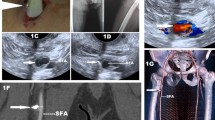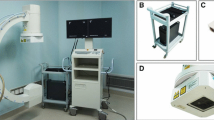Abstract
The localization and removal of a superficial foreign body is a common challenge that emergency physicians encounter. The use of ultrasonography to detect superficial foreign bodies has been well documented, but with varying success. This case report demonstrates the use of a finder needle, placed under ultrasound-guidance, to assist in the localization and removal of a glass foreign body that could not be identified after extensive wound exploration alone.
Similar content being viewed by others
Introduction
In the emergency department, the detection of a superficial foreign body is a common and important task. There are several modalities available for identifying foreign bodies. While the use of ultrasonography to detect foreign bodies has been described with varying success, it may be the most reliable method for detecting nonradiopaque material [1]. If not identified and removed, superficial foreign bodies may cause substantial morbidity and represent a significant medicolegal liability [2]. The use of bedside ultrasonography is effective not only for identifying, but more importantly may be useful in the localization and removal of superficial foreign bodies.
Case report
A 24-year-old male presented to the emergency department after breaking his car door window with his elbow. His vital signs were within normal limits, and his only complaint was a left arm laceration. On physical examination, there was a 4 cm laceration on the posterior aspect of his left arm, just proximal to the olecranon. The patient’s neurovascular examination was normal, with full range of motion and strength in the arm. A 3-view plain radiograph of the left elbow was performed, and identified 2 small radio-opaque foreign bodies (Fig. 1). After extensive exploration of the wound, the emergency physician was unable to locate the foreign bodies. With the use of focused emergency bedside ultrasonography, the emergency ultrasound fellow was immediately able to localize the foreign body, which was lodged 2 cm distal to the wound edge and approximately 1 cm beneath the skin (Fig. 2). Under ultrasound-guidance, a 22-gauge finder needle was then inserted adjacent to the foreign body (Fig. 3). The emergency physician, using the finder needle as a guide, extended the laceration distally and was able to dissect down to the foreign bodies. Two pieces of glass measuring 4 mm × 3 mm were removed from the patient’s wound.
Discussion
Locating and removing a foreign body is a challenge that emergency physicians commonly encounter. Patients presenting with an open wound should always raise suspicion for a potentially embedded foreign body [3]. While ultrasonography can be used to diagnose the presence of soft tissue foreign bodies, its success in several studies has been variable [2, 4–6]. The current indications by the American College of Emergency Physicians (ACEP) for obtaining a focused emergency soft tissue ultrasound include the evaluation for soft tissue infection, foreign bodies, and cutaneous masses [7]. Currently plain radiographs are more accessible, easier to interpret by nonradiologists, and are not as operator-dependent as ultrasonography. However, while metal and glass are radio-opaque and usually apparent on plain radiographs, plastic and wooden foreign bodies are nearly always missed [6]. In addition, while radiographs may be more accessible and easily interpreted, they are generally less useful in the removal of a foreign body.
Soft tissue foreign bodies may demonstrate a variety of sonographic patterns depending on several factors including composition, size, and length of time embedded. Common materials such as wood, glass, metal, plastic, and gravel will generally appear hyperechoic, with posterior shadowing. Foreign bodies retained for longer than 24 h are frequently surrounded by a hypoechoic “halo” due to surrounding edema, pus, or granulation tissue [6].
Whether radio-opaque or radiolucent, once the foreign body has been identified, the next and often more difficult task is to localize and remove it. Unsuccessful removal of soft tissue foreign bodies may result in further tissue injury, infection, and problems with wound healing [8]. In this case report, the surrounding area was anesthetized, and a 22-gauge finder needle was inserted under ultrasound-guidance adjacent to the foreign body. Ultrasonography may be used to identify a soft tissue foreign body, but perhaps the more useful application in the emergency department is the localization and removal of it.
References
Ginsburg M, Ellis G, Flom L (1990) Detection of soft-tissue foreign bodies by plain radiography, xerography, computed tomography, and ultrasonography. Ann Emerg Med 19:701–703
Hill R, Conron R, Greissinger P, Heller M (1997) Ultrasound for the detection of foreign bodies in human tissue. Ann Emerg Med 29:353–356
Geria R (2008) Foreign body localization. http://Sonoguide.com
Lyon M, Brannam L, Johnson D, Blaivas M (2004) Detection of soft tissue foreign bodies in the presence of soft tissue gas. J Ultrasound Med 23:677–681
Manthey DE, Storrow AB, Milbourn JM, Wagner BJ (1996) Ultrasound versus radiography in the detection of soft-tissue foreign bodies. Ann Emerg Med 28:7–9
Ma OJ, Mateer JR, Blaivas M (2008) Emergency ultrasound. 2nd edn. The McGraw-Hill Companies, New York (Printed in China)
American College of Emergency Physicians. Policy statement. Emergency ultrasound guidelines (2008)
Lammers RL (1998) Soft tissue foreign bodies. Ann Emerg Med 17:1336–1347
Conflict of interest statement
None.
Author information
Authors and Affiliations
Corresponding author
Rights and permissions
Open Access This article is distributed under the terms of the Creative Commons Attribution 2.0 International License ( https://creativecommons.org/licenses/by/2.0 ), which permits unrestricted use, distribution, and reproduction in any medium, provided the original work is properly cited.
About this article
Cite this article
Mau, J.K.L., Nelson, M. & Raio, C. Ultrasound-guided foreign body localization and removal using a finder needle. Crit Ultrasound J 1, 69–71 (2009). https://doi.org/10.1007/s13089-009-0015-6
Published:
Issue Date:
DOI: https://doi.org/10.1007/s13089-009-0015-6







